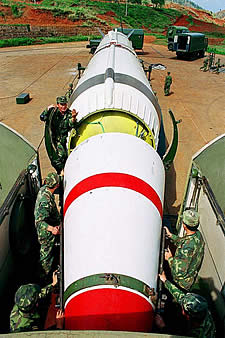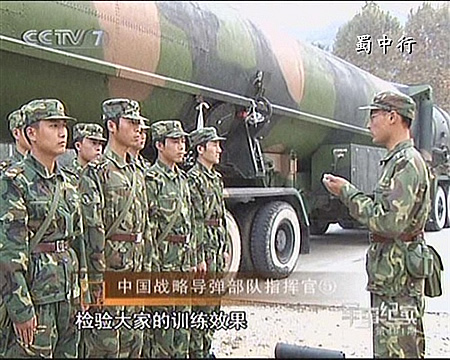China Defense White Paper Describes Nuclear Escalation
 |
.
By Hans M. Kristensen
A Chinese government defense white paper for the first time describes how China’s nuclear forces would gradually be brought to increased levels of alert during a crisis to deter an adversary and retaliate to nuclear attack.
The paper describes a growing portfolio of deterrence and counterattack capabilities with an ambitious agenda to control war situations with a more flexible deterrent and strategy.
Despite shortcomings, the paper provides a new level of Chinese transparency about its forces and planning.
Nuclear Escalation Phases
The white paper describes how the Second Artillery Corps (or Force, the term used by the paper) would change the operational status of the nuclear forces at different levels of crisis and conflict. Three levels of escalation are described:
Peacetime: Under normal circumstances – “in peacetime” – China’s nuclear missiles are “not aimed at any country.” The term “not aimed at any country” seems borrowed from U.S. terminology where it refers to the absence of targeting data in a missile’s guidance system rather than the alert level of the weapon. It has been assumed for many years that Chinese warheads were not mated with liquid-fuel missiles under normal circumstances (The situation with solid-fuel missiles has been less clear but might be similar).
|
Figure 1: |
 |
|
A warhead section is mated with a DF-3 liquid-fuel ballistic missile. Chinese nuclear warheads are thought to be stored separate from the missiles in peacetime. Image: web |
Nuclear crisis: If China comes under a nuclear threat, the nuclear missile force of the Second Artillery Corps “will go into a state of alert, and get ready for a nuclear counterattack to deter the enemy from using nuclear weapons against China.” In this phase, depending on the situation, mobile missiles would probably be dispersed to their deployments areas and presumably be aimed at the particular threat. If nuclear warheads were not already mated, they would be so too.
Nuclear attack: If China is attacked with nuclear weapons, the nuclear missile force of the Second Artillery Corps “will use nuclear missiles to launch a resolute counterattack against the enemy either independently or together with the nuclear forces of other services.” The “nuclear forces of other services” probably refers to the navy’s SSBNs and the Air Force’s bombers (see below).
Nuclear Missile Submarines
The submarine force is said to be equipped with “nuclear-powered strategic missile submarines,” a vague reference to the small fleet of perhaps 3-4 Jin-class SSBNs under construction.
The first was spotted at Xiaopingdao Submarine Base in 2007 and Hainan Island in 2008, the old Xia ended a multi-year overhaul at Jianggezhuang Submarine Base in 2008, although its operational condition is unknown.
The mission of the SSBNs is said to be “strategic deterrence and strategic counterattack,” which probably means non-alert operations in peacetime, increased readiness in a crisis, and the ability to counterattack in wartime. The paper states that the ability to counterattack is being improved, probably a reference to the new JL-2 SLBM on the Jin-class.
The mission description is vague and inconsistent. Whereas the section describing the navy’s development history uses the term “strategic deterrence and strategic counterattack,” the general force building section states that, “the submarine force possesses underwater anti-ship, anti-submarine and mine-laying capabilities, as well as some nuclear counterattack capabilities.”
Why the authors have used “strategic deterrence” in one part but only “nuclear counterattack capabilities” in the second part is unclear. Whether it is a vague reference to a nuclear cruise missile capability being added to some attack submarines is unknown, but absent any additional information might just be a matter of language.
A New Air Force Capability?
The Air Force section is interesting because it describes a “transition from territorial air defense to both offensive and defensive operations.” While much of this has to do with the introduction of new and more capable fighter and bomber aircraft and new concepts of operations, the white paper also describes “certain capabilities to execute long-range precision strikes and strategic projection operations.”
The force building section adds that in addition to traditional air force missions such as strikes and air defense, the transition involves increasing the capabilities for “strategic projection, in an effort to build itself into a modernized strategic air force.”
A small portion of China’s H-6 bombers have for decades been thought to have a secondary nuclear mission with gravity bombs, but the language in the white paper appears to go beyond that and might refer to some of the H-6 bombers being upgraded to carry a new long-range cruise missile intended for land-attack missions.
Most new cruise missiles will carry conventional explosives, but at least one – possibly the DH-10 – might also have a nuclear capability. The operational status of a nuclear cruise missile is highly uncertain and may initially be ground-launched, yet the U.S. Defense Department’s 2008 projection for Chinese nuclear forces vaguely referred to “new air- and ground-launched cruise missiles that could perform nuclear missions” and therefore “improve the survivability, flexibility, and effectiveness of China’s nuclear forces.”
Whether that means China is deploying nuclear cruise missiles remains to be seen.
Nuclear Weapons Capabilities
The paper describes that China over the past decades has built a weaponry and equipment system with both nuclear and conventional missiles, both solid-fueled and liquid-fueled missiles, with different ranges and “different types of warheads.”
The safety and surety features of those warheads and the personnel that handle them have been changed, the white paper states. For example, safety measures have been established to “avoid unauthorized and accidental launches,” measures that are needed for enhancing security but probably also for enhancing command and control of the weapons in the increasingly flexible scenarios the paper describes.
|
Figure 2: |
 |
| Do Chinese solid-fuel DF-31 and DF-31A long-range ballistic missiles carry nuclear warheads in peacetime? In a crisis they most likely would under the escalation procedures described in the 2008 Defense White Paper. Image: CCTV7 |
.
Nuclear Weapons Policy
The white paper states that new military strategic guidelines have been issued that are aimed at “winning local wars in conditions of informationization.” The new guidelines stress “deterring crises and wars,” and “effectively control war situations,” and calls for “the building of a lean and effective deterrent force and the flexible use of different means of deterrence.”
Hovering above that evolution is a long-held policy of no-first-use of nuclear weapons, a self-defensive nuclear strategy, and a pledge never to enter into a nuclear arms race with any other country.
The good news about the no-first-use policy is that it is explicitly nuclear focused, and that China does not yet appear to have made it conditional on specific situations such as conventional attacks against China’s nuclear forces. This is important because some Chinese officials privately insist that a conventional attack against China’s nuclear forces would be considered a nuclear attack and the no-first-use policy therefore not a limiting factor in China’s response.
The not so good news is that the no-first-use policy in certain situations doesn’t seem credible. The pledge to “not be the first to use nuclear weapons at any time and in any circumstances” means that if an adversary invaded China and threatened the survival of the state, China’s nuclear forces would not be used as long as the invader did not use nuclear weapons. Hardly a credible policy.
Likewise, the pledge to “unconditionally not use or threaten to use nuclear weapons against non-nuclear-weapon states or in nuclear-weapon-free zones,” means that if the United States staged strikes against China from Japan or South Korea, Chinese nuclear weapons would not be used against U.S. bases in those countries. In that credible?
Despite these “credibility issues” in Chinese nuclear policy, the white paper is noteworthy because it indicates that China – unlike the other nuclear weapon states – has not yet fallen for the temptation to broaden its nuclear policy to deter all forms of weapons of mass destruction. The policy seems entirely focused on deterring and responding to nuclear attacks.
The white paper also states that China would like the nuclear weapon states to stop research into and development of new types of nuclear weapons, reduce the role of nuclear weapons in their national security policy, and reduce their nuclear arsenals. Those are good policy goals but they ring hollow given that China is busy deploying new nuclear weapons with new nuclear warheads and is the only of the five original nuclear weapon states that is thought to be increasing its nuclear arsenal.
As China increases its capabilities and pursues a more flexible deterrent posture, there is a risk that its policies will be modified too. With increased flexibility in capability tends to come increased flexibility in mission.
Oh, and in case you wondered: while the U.S. military plans against “red forces,” the Chinese plan against “blue forces.” Some things never change.
While advanced Chinese language proficiency and cultural familiarity remain irreplaceable skills, they are neither necessary nor sufficient for successful open-source analysis on China’s nuclear forces.
Satellite imagery has long served as a tool for observing on-the-ground activity worldwide, and offers especially valuable insights into the operation, development, and physical features related to nuclear technology.
This report outlines a framework relying on “Cooperative Technical Means” for effective arms control verification based on remote sensing, avoiding on-site inspections but maintaining a level of transparency that allows for immediate detection of changes in nuclear posture or a significant build-up above agreed limits.
The grant comes from the Carnegie Corporation of New York (CCNY) to investigate, alongside The British American Security Information Council (BASIC), the associated impact on nuclear stability.